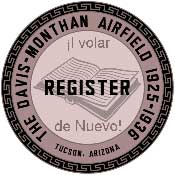|
Hugh Wells came to Tucson on Friday, May 18, 1928 at 12:15PM carrying
seven passengers. Their airplane was a 14-passenger Fokker F-10, NC5358. The passengers were listed in the
Register, so we know who they were: Local journalist
Mrs. Bernice Cosulich of the Arizona Daily Star, Tucson,
D.R. Lane, H.D. Maier, W.R. Yahner (Pittsburgh, PA newspaper man), James T. King (mechanical superintendent for Western Air Express), and Lt.
and Mrs. R.C. Moffat. Wells is described, along with some of his passengers, in this article from the Los Angeles Times, May 21, 1928. Wells was flying one of three F-10s across the country that week. Airplane number one was flown by Peterson Field Register pilot Silas Morehouse. Does anyone KNOW the registration number of Morehouse's airplane? Below, courtesy of the San Diego Aerospace Museum (SDAM) Flickr Stream, is a photo postcard of Wells' Fokker. Although no number is visible on the airplane, the caption identifies Wells as the pilot.
Wells' Fokker F-10, Probably NC5358, Ca. 1928 (Source: SDAM via Woodling)
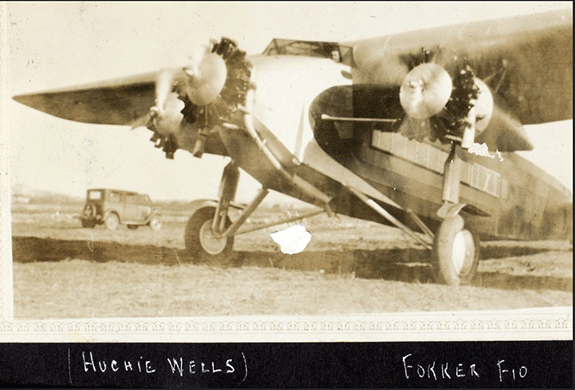 |
Wells and his party departed Tucson, probably after enjoying lunch, the same day at 2:30PM bound for Phoenix, AZ.
Hugh Wells, Date & Location Unknown (Source: NASM)
 |
Theirs was a goodwill voyage as indicated
in the Remarks column of the Register. They were
traveling, "From Teterboro Airport, N.J. to Los Angeles,
final destination." Further, the flight was sponsored
by the, "California Development Association Goodwill
Tour, Plane No. 3". Los Angeles appeared to be
the first stop on the west coast, but they would continue, "To
San Francisco/ Western Air Express #3". The LA Times article cited above places this flight in context, even though the newspaper describes Wells' airplane as #2. Wells is identified as chief test pilot for Fokker aircraft at the time.
Portrait, left, from his dossier at the Smithsonian states, "Portrait shot of air mail pilot Hugh I. Wells, written on reverse, 'Hugh Wells, first mail pilot out of Boston, 1926 -- now flying in South America [see below].'"
Indeed, a copy of the two-page airmail route contract signed by Wells and E.S. Sunngerty on behalf of Colonial Air Transport, for whom Wells flew the mail, is below. This document is an amendment to the original, which was signed November 7, 1925. This amendment was signed July 1, 1926 and appeared to adjust the price per pound of transported mail to $3 per pound "including equipment."
Airmail Route Contract, Amended, Page 1, July 1, 1926 (Source: Woodling)
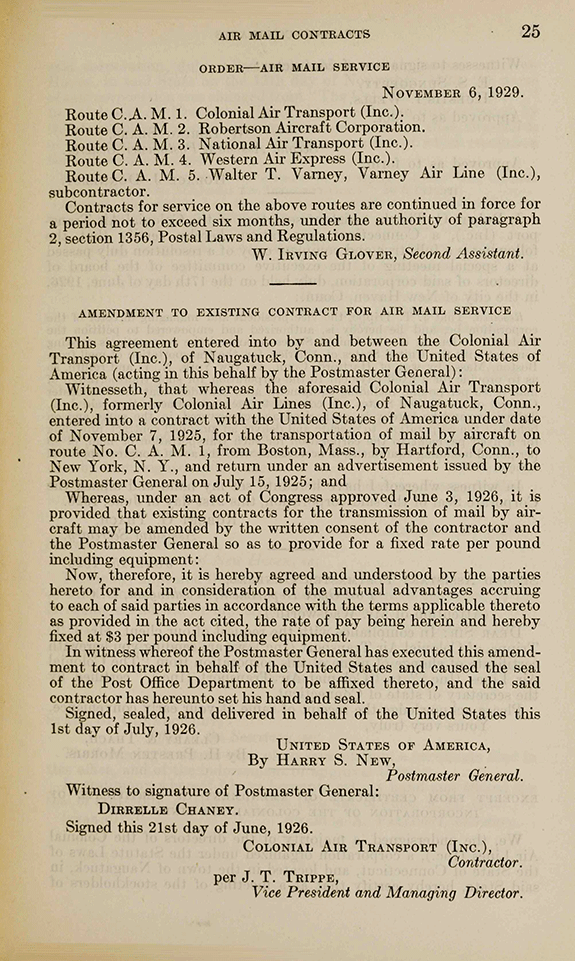 |
Page two follows, signed by "Huestis I. Wells." Note that Juan Trippe, later Pan Am CEO, was vice president and managing director of Colonial air Transport in 1926. In 1927 Wells was working for Juan Trippe as a Colonial Airlines airmail pilot on the Boston-New York run and later as a pilot on the Miami to Havana run for Pan American Airways.
Airmail Route Contract, Amended, Page 2, July 1, 1926 (Source: Woodling)
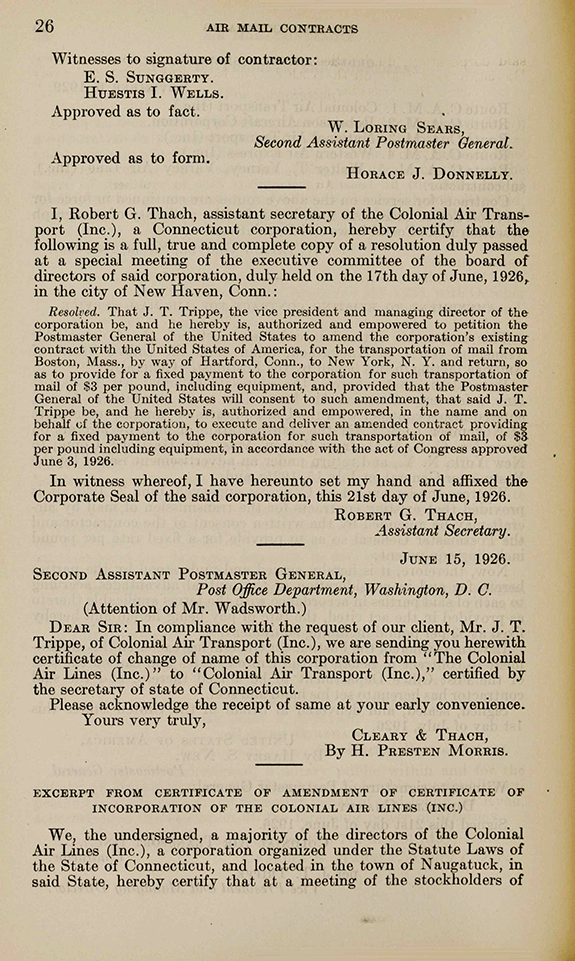 |
In 1928 Wells was chief pilot for Fokker in New Jersey and also worked for Register pilot Clarence Chamberlin. His chief pilot status probably explains his participation in the goodwill tour that brought him through Tucson. His work with Chamberlin was completely different. An article in the Reading, PA Times of September 7, 1928 explains, below.
CHAMBERLIN PLANS PASSENGER AIRLINE
WASHINGTON, Sept. 6. Clarence Chamberlin plans to start an amphibian passenger airline between New York and Washington next week, he has informed friends here. He said he would act as his own pilot at first, later turning the controls over to Hugh Wells, now Fokker test pilot. As the service expands he will add more amphibian planes, he said. Chamberlin expects to make his landing in the Hudson river, at Eightieth street, New York, and in the Potomac river here. He expects to leave New York dally at 10:30 a. m. eastern daylight time and Washington at 3 p.m. eastern standard time. The trip each way will take two and one - half hours. |
I am not sure if Chamberlin's planned airline reached fruition, but there was a crash of an amphibian aircraft, piloted by Wells with Chamberlin aboard, that might have meant its delay or demise, below. A Loening amphibian in which they were flying suffered a landing gear failure.
Accident Report, Ca. 1928 (?) (Source: Woodling)
 |
The 1930 U.S. Census placed Wells at age 30 living in a rented home ($100 per month) at 4030 Poinciana Avenue in Miami, FL, employed as a "Chief engineer" in the "Aviation" industry. This was probably the work he did for Juan Trippe and Pan Am. He was married in 1926 to Ruth T. (24) and they had a two year old daughter, Jacqueline T. Also in the household was Laura G. True (31), an aunt.
Postal Cachet Signed by Wells, July 20, 1930 (Source: Web)
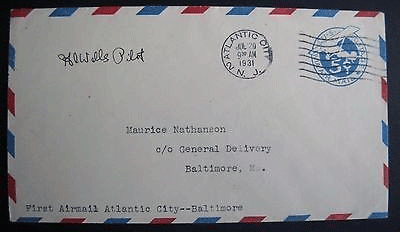 |
Two news articles in Wells' NASM file focus on his South American work. One brief one, from the Newark Star Eagle of Friday February 7, 1930, states, "The flight of Hugh Wells from New York to Rio de Janeiro was interrupted at Norfolk, where he is in the hospital with influenza."
He was in the northern U.S. at least in July, 1930. The Wells-signed postal cachet, left, documents first airmail flown from Atlantic City, NJ to Baltimore, MD July 20, 1930.
Acknowledgement from The Physical Review, October 1, 1936
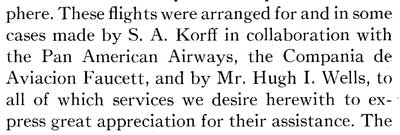 |
He participated during 1936 in high altitide research in South America and was credited with collecting cosmic ray data while aloft (see Physical Review article cited in left sidebar). A passage from the article is at right.
His adventures in aviation continued in South America as illustrated by the following news article dated March 1, 1941.
Unsourced News Article, March 1, 1941 (Source: NASM)
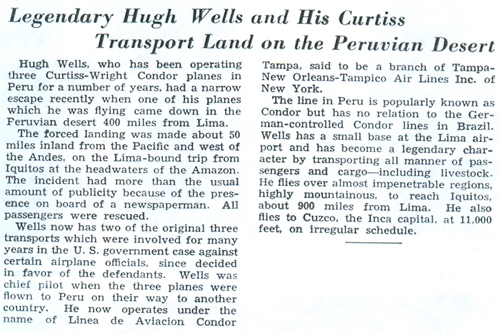 |
The New York Times, October 13, 1935 (Source: NYT via Woodling)
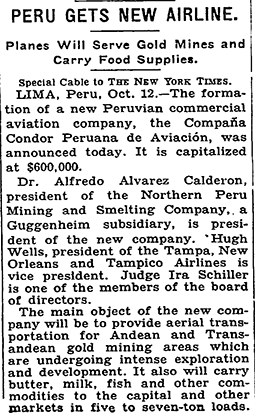 |
The background for this 1941 article is instructive. The article at left, from The New York Times of October 13, 1935, cites the formation of a new airline based in Lima, Peru. Wells was appointed vice president of the new company.
On February 23, 1937, Wells received permission to import four Curtiss-Wright Condors, large, twin-engine biplanes, into Peru. His company's intention was to begin passenger and freight service.
The New York Times, May 23, 1939 (Source: NYT via Woodling)
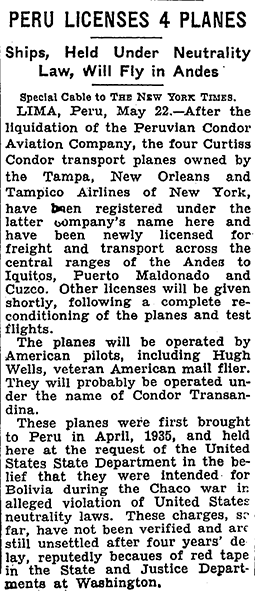 |
According to this REFERENCE by Davies, p. 294, both the U.S. and Peruvian governments feared that the four aircraft might be taken over and used in the Bolivian-Paraguayan Bran Chaco Border war, which was then in full swing. The political and diplomatic ramifications were too great to risk. The article at right, from The New York Times of May 23, 1939, suggests the airplanes were "held" unused by the Peruvian government under charges of alleged violations of neutrality laws. At the time of this article the alleged neutrality law violation was still unresolved. An earlier (January 13th) article in the Times, described the airline as a "dummy concern," set up expressly to transfer the aircraft to South America where they could be used in the dispute.
The New York Times, February 24, 1941 (Source: NYT via Woodling)
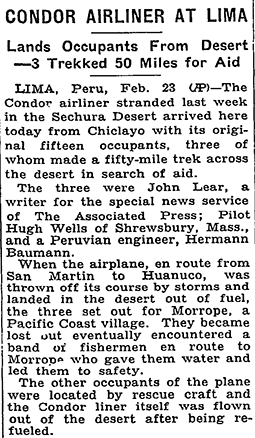 |
Davies, however, explains that, rather than allow passenger flights, the governments only allowed Wells to fly freight and to perform photographic surveys. His high-altitude contributions collecting cosmic ray data while aloft may explain this. At that, Wells was still accused of violating U.S. neutrality laws.
So, by 1939, Wells was involved with establishing Linea de Aviacion Condor Tampa with his four aircraft. His airline began passenger service from Lima to Iquitos, via Huánuco, Tarapoto and Yurimaguas.
The article at left was published in 1941 a week or so earlier than the one above and cites the forced landing in the desert. It also cites and credits Wells and two other passengers with walking out of the desert and affecting rescue for the remaining passengers.
Linea de Aviacion Condor Tampa (Source: Davies via Woodling)
 |
Additional history was provided by the snip at right from Davies, page 297. It is clear that Wells' operation was viable for a scant four years, 1938-1941. The impending WWII precluded any restart of the business by Wells, perhaps using more modern aircraft.
The image below is from Davies' book, page 294 and shows one of his Curtiss Condors in harness. Note the sizeable load of tobacco to be placed on board with fuel enough for at least 5.5 hours of flight plus ground operations.
Curtiss Condor of Linea de Aviacion Condor Tampa (Source: Davies via Woodling)
 |
The photograph below is from the New York Herald Tribune of Wednesday, July 31, 1946. This and two other photos in the same spread describe Wells' search for office space at LaGuardia Airport, perhaps in anticipation of his New York to Lima, Peru airline plans (below).
New York Herald Tribune, July 31, 1946
(Source: NASM)
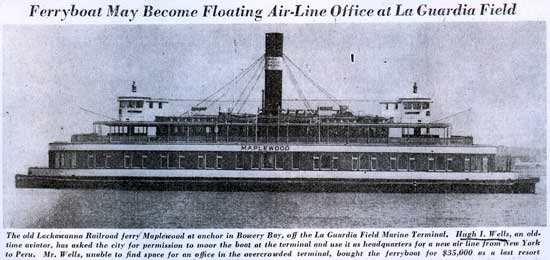 |
The main cabins of the boat were to be converted to waiting rooms. Note that Wells is identifed as an "old-time aviator" in the photo caption, and that his "new" airline was to fly from New York to Peru. In 1954, an article in the Evening Times of Cumberland, MD, reported that Wells had purchased a Sikorsky flying boat in 1949, refurbished it, and was intending to fly it to Lima, Peru for passenger and freight transport. Details are in the article, below.
The Evening Times, Cumberland, MD, July 13, 1954 (Source: Woodling)
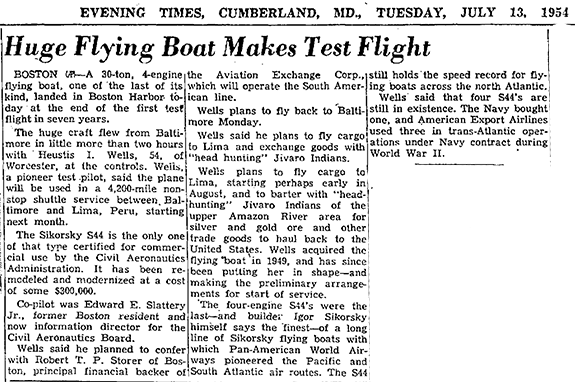 |
I don't know if this airline ever became reality, but if it did he had ten years to operate it. Wells passed away on March 17, 1964. His obituary from The New York Times is below. Wells was born September 4, 1900.
Heustis I. Wells Obituary, The New York Times, March 18, 1964 (Source: NYT via Woodling)
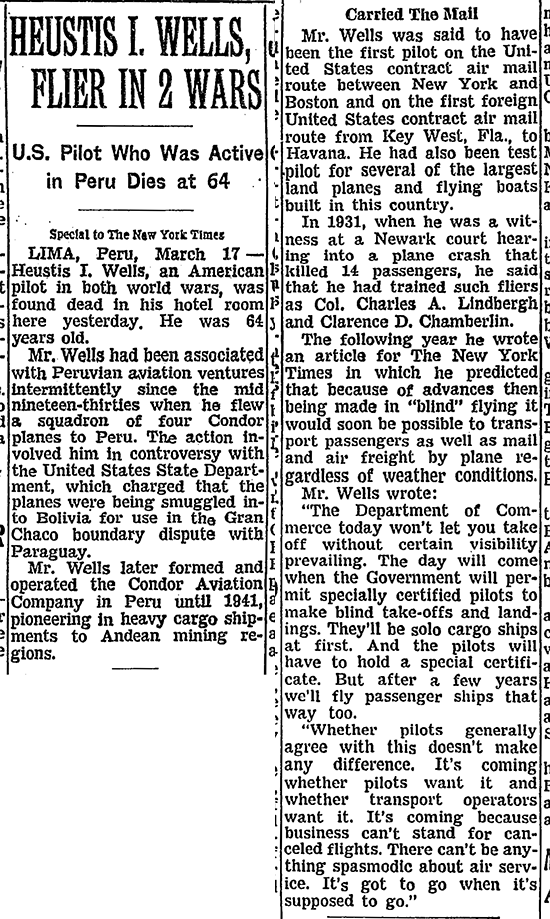 |
---o0o---
Dossier 2.1.164
UPLOADED: 12/16/10 REVISED: 03/29/16
|

